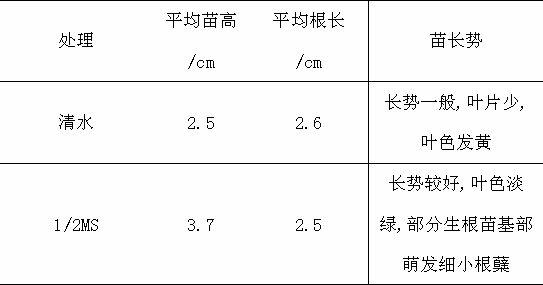Method for rooting of horseradish outside tissue culture seedling bottle
A technique for tissue culture seedlings and exogenous rooting, which is applied in the field of plant reproduction, can solve the problems of long reproduction cycle and high production cost, and achieve the effects of lowering costs, lowering production costs and shortening the reproduction cycle.
- Summary
- Abstract
- Description
- Claims
- Application Information
AI Technical Summary
Problems solved by technology
Method used
Image
Examples
Embodiment Construction
[0012] The growth of adventitious buds has a great influence on the rooting rate. The adventitious buds are taken from the top buds or side buds of wasabi, washed with tap water, peeled off the outermost layer under aseptic conditions, and then sterilized with 70% alcohol for 30-60 s, then took the shoot tip under a microscope, and inoculated In adventitious bud induction medium (MS + NAA 0.5 mg·L -1 + 6-BA 0.5 mg·L -1 + 30 g·L sucrose -1 + agar 7 g·L -1 , pH 5.8), cultured at 17±1°C, inoculated in subculture medium ( MS + 6-BA 1 mg·L every 25 days -1 + 30 g·L sucrose -1 + agar 7 g·L -1 , PH 5.8) to subculture once. When the sprouts grow to about 2cm, loosen the bottle cap of the culture bottle, train the seedlings in the acclimatization room for 3 days, then take out the rootless seedlings from the bottle, clean the remaining medium, and choose vigorous, strong and indeterminate sprouts with a length of about 2 cm. The sprouts are the material. Cut the sprouts into si...
PUM
 Login to View More
Login to View More Abstract
Description
Claims
Application Information
 Login to View More
Login to View More - R&D
- Intellectual Property
- Life Sciences
- Materials
- Tech Scout
- Unparalleled Data Quality
- Higher Quality Content
- 60% Fewer Hallucinations
Browse by: Latest US Patents, China's latest patents, Technical Efficacy Thesaurus, Application Domain, Technology Topic, Popular Technical Reports.
© 2025 PatSnap. All rights reserved.Legal|Privacy policy|Modern Slavery Act Transparency Statement|Sitemap|About US| Contact US: help@patsnap.com

